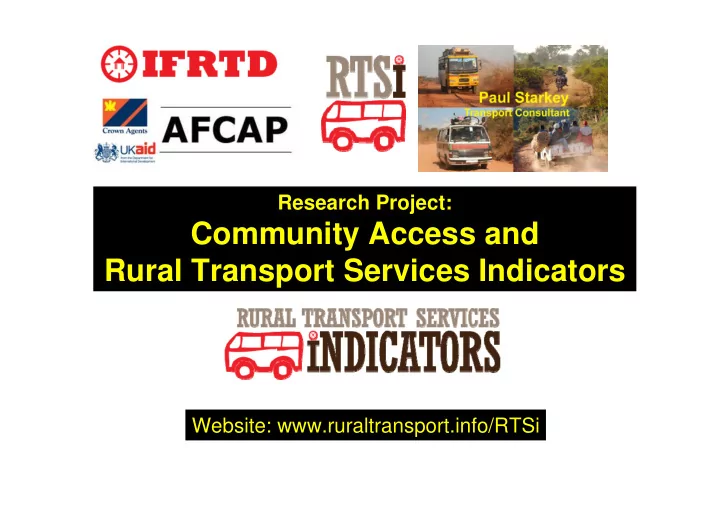

Research Project: Community Access and Rural Transport Services Indicators Website: www.ruraltransport.info/RTSi
Research objective • Research aims to identify, develop, test and share rural transport services indicators relevant to the key stakeholders, including rural people, transport operators, regulators, planners, roads authorities and development agencies. • Outcome will be appropriate rural transport services indicators that are tested and disseminated to the transport sector in various African countries. • To be achieved using participative methodologies involving local stakeholders and sector experts.
Key points • RTS indicators to be representative of one rural road that is surveyed • RTS indicators to allow comparisons over time and space (changes in road, differences between roads) • RTS indicators to be relevant to stakeholders • RTS indicators to be responsive (change with interventions) • RTS indicators to be repeatable (same result if no change) • RTS indicators to be ‘actionable’ (policy action could change them)
Implementing team • Paul Starkey (Team Leader) • Peter Njenga (Project Manager). • Dr Kenneth Odero (Kenya Research) • Guy Kemtsop (Tanzania Research) • Shedrack Willilo (Tanzania Research) • Dr Musyimi Mbathi (GIS support) • Also • International Project Consultative Group • National Steering Committees
RTSi perspectives • Four different perspectives used each with appropriate information sources: • Users • Operators • Regulators • Development personnel
User perspective indicators 1 All to be disaggregated for transport modes All to be disaggregated user types including gender, disability and age • Fares for using transport services • Availability of service • Predictability of service • Space available on service • Travel speed of service • Safety of service • Security of journey • Comfort of service
User perspective indicators 2 • Application of ‘universal design’ in RTS and related infrastructure • Choice of travel mode • Choice of service provider • Small freight transport by service • Intermodal convenience • Mobile phones and RTS • Facilities at terminal and roadside stops • Courier facilities
Operator perspective indicators • Road infrastructure • Market demand • Income from providing RTS • Costs of providing RTS • Profitability of RTS • Financial services for RTS • Technical services for RTS • Disincentives for providing RTS • Incentives for providing RTS • Competition for market share • Cooperation in service provision • Security for RTS
Regulator perspective indicators • Technical regulation of vehicles • Tax, third party insurance, and permit regulations for RTS provision • Passenger insurance • Regulation for RTS operations • Planning for RTS provision • Environmental issues in RTS provision • Safety
Development perspective indicators • Support for local industries (eg agriculture) • Multi-modal integration • Cultural / heritage impact • Environmental impact • HIV/AIDS • Women’s empowerment through RTS • Ethnic minorities’ empowerment with RTS • Disabled people’s empowerment with RTS • Youth empowerment through RTS • Support for health services • Support for education services • Integration of ICT in RTS • Road maintenance
Envisaged inputs once developed • To implement methodology about 8 survey days around the road two reporting days (ie, about two weeks total) Performed by one medium-ranking, trained professional
Envisaged outputs once developed 1 • 1) Overall indicators of RTS features (numerical or graphical, still to be developed) • 2) One page summary table and charts with: Map of road, hub and spoke context and GPS ride printout. All component indicators (disaggregated for vehicle type and user categories) Including frequency, user satisfaction, safety, freight tariffs, regulation, development impacts Summary of RTS fares, costs, and profitability (disaggregated) Overall traffic and passenger flows
Envisaged outputs once developed 2 • 3) Four-page summary report following agreed international format and heading summarising issues identified relating to service operations, user needs, operator requirements, regulatory issues and development issues (including environment, health, gender, education) and policy issues. • 4) Open-ended report discussing issues for commissioning organisation
Methodology and work plan • Phase 1: April to September 2012 Pilot development and testing of the methodology Short ‘surveys’ on selected roads in Tanzania and Kenya Rigorous analysis of the results and methods Modified surveys and analyses and re- assessments (four?) • July milestone: a report describing the draft methodology, initial results and suggested indicators • If good progress, then Phase 2-4 (validation testing with other organisations and other countries)
Research Project: Community Access and Rural Transport Services Indicators Website: www.ruraltransport.info/RTSi Asante sana
Recommend
More recommend